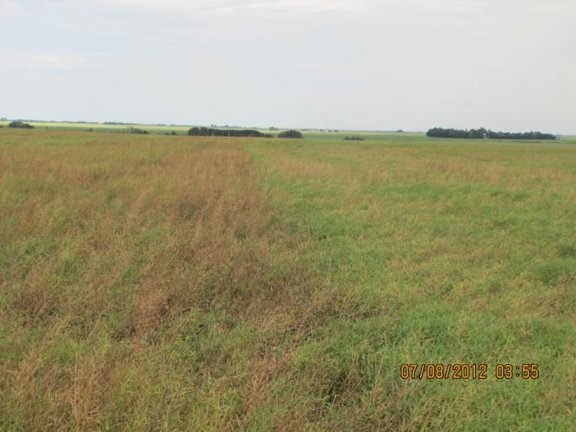Western Canadian canola growers must take proactive approach against Sclerotinia

Western Canadian growers have long been familiar with Sclerotinia stem rot. One of the most predominant canola diseases in the region, Sclerotinia was observed in 80 per cent of surveyed crops in a 2020 study,1 with fields with high inoculum loads and environmental conditions favorable to the disease experiencing up to 50 per cent yield loss.
While no one knows your field better than you, it’s imperative to take a proactive, multi-pronged approach against Sclerotinia to protect your crops and your profits. Below, you will find tips and advice on how you can maximize your protection against the disease and reduce yield loss today and in the future.
Infection occurs during flowering from airborne spores and is highly dependent on weather conditions at the time of infection.
Wet conditions, moist soil, high humidity and temperatures between 15-25°C within the crop canopy are conducive to sclerotia germination. Once infected, the disease can cause lesions, bleached and weak stems, premature ripening, crop lodging and reduced yields from fewer pods and seeds.
Yield loss calculator
- Yield losses are estimated to be half the level of infection.
- To calculate revenue loss/acre, multiply percent potential yield loss by estimated yield by cost per bushel.
To protect your canola yield, here are some proactive steps you can take to manage your crop’s risk from Sclerotinia:
Grow a Pioneer® Sclerotinia resistant canola hybrid
Practice crop rotation
Use a foliar fungicide
Risk assessment and scouting
When deciding to use a fungicide, consider the economics
Take a canola field with an estimated yield of 40 bushels per acre that is expected to sell for $20 per bushel. If the yield loss due to Sclerotinia infection is only 15%, the revenue loss would be $120 per acre. If the cost of fungicide application was $30 per acre, then spraying a fungicide for Sclerotinia control would be very economical, in this example.
The first step to protecting your canola yield is growing a Sclerotinia resistant hybrid. Genetic resistance to Sclerotinia means the plant recognizes the infection process and works to reduce disease transfer to the stem. At Pioneer, we breed Sclerotinia tolerance using several sources, and objectives are focused on increasing levels of resistance in concert with improvements in agronomy and yield.
Providing season-long control, Pioneer® brand canola hybrids with the Sclerotinia trait can reduce disease development by over 65 per cent, as well as lessen disease transfer through a reduction in disease transfer to the stem and reduction of disease severity in infected stems.
Pioneer was the first agriculture company to introduce Sclerotinia resistant canola hybrids in 2008 and is one of two premium seed brands offered by Corteva Agriscience™. In development for over 20 years, the agronomic trait provides growers with peace of mind and protection when environmental conditions are conducive to Sclerotinia infection within their canola fields. Corteva is also hard at work developing the next generation of Sclerotinia resistant hybrids with the intent of reducing the incidence of the disease up to 80 per cent.
The Pioneer® brand Sclerotinia trait is built right into high yielding canola hybrids such as Pioneer® brand P617SL and P505MSL. Along with industry-leading Sclerotinia resistance, these hybrids also offer industry-leading protection from yield-robbing diseases such as clubroot (including new sources of resistance), blackleg and verticillium wilt - all in one complete package.  Susceptible Canola Hybrid (left), Sclerotinia Resistant Canola Hybrid (right)
Susceptible Canola Hybrid (left), Sclerotinia Resistant Canola Hybrid (right)
Maximize protection and reduce yield loss under severe disease pressure
Under high Sclerotinia pressure environments or areas prone to the disease, it’s best practice to make a proactive foliar fungicide application to protect your investment when choosing a Sclerotinia resistant hybrid and maximize your yield.
Acapela™ is a one-of-a-kind fungicide that quickly and efficiently surrounds, penetrates and protects the leaf and stem. Rapid absorption moves the fungicide quickly and efficiently into and within each plant, allowing application to occur even when field conditions are challenging, so growers get healthier crops and higher yield potential. To maximize control, ideal timing is approximately 20-30 per cent bloom or before very few petals have fallen off the plants.
By choosing a Pioneer® canola hybrid with built-in Sclerotinia resistance and proactively applying a foliar fungicide like Acapela, you can maximize protection and reduce yield loss under severe disease pressure.
For more information on finding the right canola products with Sclerotinia resistance for you, contact your local Pioneer Sales Representative.
Join Scott McClinchey at one of our Canola Research Stations as he discusses Sclerotinia management strategies and what Pioneer is doing to help Western Canadian canola farmers maximize protection.